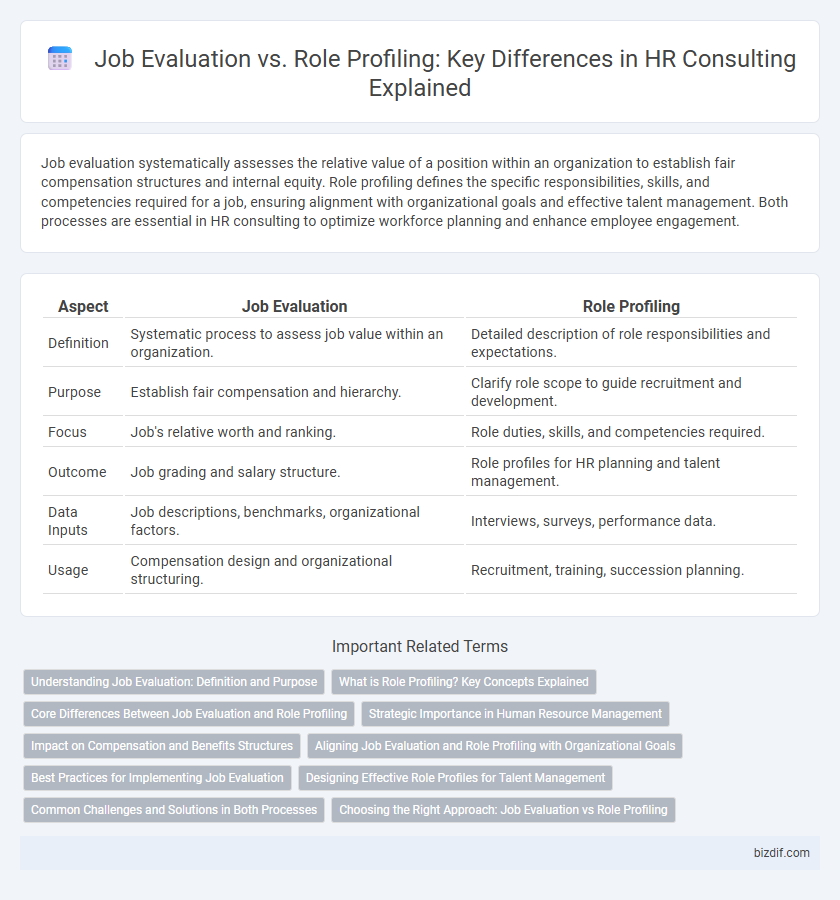Job evaluation systematically assesses the relative value of a position within an organization to establish fair compensation structures and internal equity. Role profiling defines the specific responsibilities, skills, and competencies required for a job, ensuring alignment with organizational goals and effective talent management. Both processes are essential in HR consulting to optimize workforce planning and enhance employee engagement.
Table of Comparison
| Aspect | Job Evaluation | Role Profiling |
|---|---|---|
| Definition | Systematic process to assess job value within an organization. | Detailed description of role responsibilities and expectations. |
| Purpose | Establish fair compensation and hierarchy. | Clarify role scope to guide recruitment and development. |
| Focus | Job's relative worth and ranking. | Role duties, skills, and competencies required. |
| Outcome | Job grading and salary structure. | Role profiles for HR planning and talent management. |
| Data Inputs | Job descriptions, benchmarks, organizational factors. | Interviews, surveys, performance data. |
| Usage | Compensation design and organizational structuring. | Recruitment, training, succession planning. |
Understanding Job Evaluation: Definition and Purpose
Job evaluation systematically assesses the relative worth of jobs within an organization to establish fair compensation structures and internal equity. It involves analyzing job content, responsibilities, skills, and working conditions to determine job value and ranking. This process supports informed decision-making in salary administration, organizational design, and performance management.
What is Role Profiling? Key Concepts Explained
Role profiling in HR consulting defines the specific duties, skills, and responsibilities associated with a position, creating a detailed framework that guides recruitment, performance management, and career development. It captures the essential competencies and behavioral expectations required to perform successfully, facilitating alignment between organizational goals and employee capabilities. By clearly outlining role requirements, role profiling supports consistency in job design and enables effective workforce planning.
Core Differences Between Job Evaluation and Role Profiling
Job evaluation systematically assesses the value of a job within an organization based on factors such as responsibilities, skills, and working conditions to establish equitable pay structures. Role profiling, on the other hand, details the specific duties, competencies, and behavioral expectations required for a particular role, emphasizing clarity in performance and recruitment. The core difference lies in job evaluation's focus on compensation and organizational hierarchy, whereas role profiling centers on role clarity and talent management.
Strategic Importance in Human Resource Management
Job evaluation provides a systematic approach to determine the relative value of jobs within an organization, directly influencing compensation structures and workforce planning. Role profiling offers detailed insights into the responsibilities, skills, and competencies required, essential for talent acquisition and development strategies. Combining both tools enhances strategic human resource management by aligning job worth with organizational goals and employee performance metrics.
Impact on Compensation and Benefits Structures
Job evaluation systematically assesses the relative worth of positions within an organization, directly influencing compensation structures by ensuring equitable and competitive pay scales based on job complexity, responsibilities, and skills required. Role profiling provides detailed descriptions of job duties, competencies, and performance expectations, which inform tailored benefits packages aligned with each role's specific demands and career progression pathways. Together, these processes optimize compensation and benefits strategies by aligning pay and perks with organizational goals and employee contributions.
Aligning Job Evaluation and Role Profiling with Organizational Goals
Aligning job evaluation and role profiling with organizational goals enhances workforce planning by ensuring that roles are accurately assessed and defined in relation to strategic objectives. This alignment facilitates fair compensation structures and talent development pathways that directly support company growth and performance metrics. Integrating these HR processes drives clarity in job expectations while reinforcing the organization's mission and values.
Best Practices for Implementing Job Evaluation
Implementing best practices in job evaluation involves conducting thorough role analysis to ensure accurate assessment of job responsibilities, skills, and competencies. Utilizing standardized evaluation methods such as point-factor systems enhances consistency and objectivity across job classifications. Engaging stakeholders and maintaining transparency throughout the process fosters trust and alignment with organizational goals.
Designing Effective Role Profiles for Talent Management
Designing effective role profiles enhances talent management by clearly defining job responsibilities, required skills, and performance expectations, enabling accurate talent assessment and development. Unlike job evaluation, which primarily assesses job value for compensation, role profiling focuses on comprehensive role clarity that supports recruitment, training, and succession planning. Leveraging detailed role profiles ensures alignment between organizational goals and individual capabilities, improving workforce productivity and engagement.
Common Challenges and Solutions in Both Processes
Job evaluation and role profiling both face challenges such as subjective bias, inconsistent criteria application, and data accuracy issues. Implementing standardized frameworks and leveraging technology like automated assessment tools can enhance consistency and objectivity in both processes. Training HR professionals in structured methodologies ensures better alignment of job roles with organizational goals and fair compensation.
Choosing the Right Approach: Job Evaluation vs Role Profiling
Choosing the right approach between job evaluation and role profiling depends on organizational goals and workforce dynamics. Job evaluation provides a systematic method to assess job worth and establish equitable pay structures, while role profiling offers a detailed understanding of responsibilities and competencies required for performance management. HR consulting firms recommend integrating both methods to enhance talent acquisition, compensation strategies, and employee development.
Job Evaluation vs Role Profiling Infographic

 bizdif.com
bizdif.com